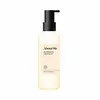What's inside
What's inside
 Key Ingredients
Key Ingredients

 Benefits
Benefits

 Concerns
Concerns

 Ingredients Side-by-side
Ingredients Side-by-side

Cetyl Ethylhexanoate
EmollientOryza Sativa Bran Oil
EmollientSorbeth-30 Tetraoleate
EmulsifyingPEG-20 Glyceryl Triisostearate
EmollientGlycerin
HumectantGlyceryl Behenate/Eicosadioate
EmollientLactococcus Ferment Lysate
Skin ConditioningKluyveromyces/Lactobacillus/Lactococcus/Leuconostoc/Saccharomyces Milk Ferment Filtrate
Skin ConditioningCeramide NP
Skin ConditioningAlgae Extract
EmollientLactic Acid
BufferingCaprylic/Capric Triglyceride
MaskingWater
Skin ConditioningSodium Chloride
MaskingSodium Benzoate
MaskingPhenoxyethanol
PreservativeCetyl Ethylhexanoate, Oryza Sativa Bran Oil, Sorbeth-30 Tetraoleate, PEG-20 Glyceryl Triisostearate, Glycerin, Glyceryl Behenate/Eicosadioate, Lactococcus Ferment Lysate, Kluyveromyces/Lactobacillus/Lactococcus/Leuconostoc/Saccharomyces Milk Ferment Filtrate, Ceramide NP, Algae Extract, Lactic Acid, Caprylic/Capric Triglyceride, Water, Sodium Chloride, Sodium Benzoate, Phenoxyethanol
Ethylhexyl Palmitate
EmollientSorbeth-30 Tetraoleate
EmulsifyingTriethylhexanoin
MaskingCetyl Ethylhexanoate
EmollientDiisostearyl Malate
EmollientCaprylic/Capric Triglyceride
MaskingOryza Sativa Bran Oil
EmollientArtemisia Vulgaris Oil
PerfumingTocopherol
AntioxidantHelianthus Annuus Seed Oil
EmollientWater
Skin ConditioningHippophae Rhamnoides Fruit Oil
Skin ProtectingGalactomyces Ferment Filtrate
HumectantButylene Glycol
HumectantGlycerin
HumectantOryza Sativa Lees Extract
Skin ConditioningPropanediol
Solvent1,2-Hexanediol
Skin ConditioningPentylene Glycol
Skin ConditioningSaccharomyces/Coix Lacryma-Jobi Ma-Yuen Seed Ferment Filtrate
Skin ConditioningSaccharomyces/Barley Seed Ferment Filtrate
HumectantSaccharomyces/Rice Ferment Filtrate
Skin ConditioningCaprylyl Glycol
EmollientLactobacillus/Rice Ferment
Skin ConditioningEthylhexylglycerin
Skin ConditioningOryza Sativa Bran Water
MaskingEthylhexyl Palmitate, Sorbeth-30 Tetraoleate, Triethylhexanoin, Cetyl Ethylhexanoate, Diisostearyl Malate, Caprylic/Capric Triglyceride, Oryza Sativa Bran Oil, Artemisia Vulgaris Oil, Tocopherol, Helianthus Annuus Seed Oil, Water, Hippophae Rhamnoides Fruit Oil, Galactomyces Ferment Filtrate, Butylene Glycol, Glycerin, Oryza Sativa Lees Extract, Propanediol, 1,2-Hexanediol, Pentylene Glycol, Saccharomyces/Coix Lacryma-Jobi Ma-Yuen Seed Ferment Filtrate, Saccharomyces/Barley Seed Ferment Filtrate, Saccharomyces/Rice Ferment Filtrate, Caprylyl Glycol, Lactobacillus/Rice Ferment, Ethylhexylglycerin, Oryza Sativa Bran Water
 Reviews
Reviews

Ingredients Explained
These ingredients are found in both products.
Ingredients higher up in an ingredient list are typically present in a larger amount.
This ingredient is an emollient, solvent, and texture enhancer. It is considered a skin-softener by helping the skin prevent moisture loss.
It helps thicken a product's formula and makes it easier to spread by dissolving clumping compounds.
Caprylic Triglyceride is made by combining glycerin with coconut oil, forming a clear liquid.
While there is an assumption Caprylic Triglyceride can clog pores due to it being derived from coconut oil, there is no research supporting this.
Learn more about Caprylic/Capric TriglycerideCetyl Ethylhexanoate is an emollient ester. It comes from cetearyl alcohol and 2-ethylhexanoic acid.
Cetyl Ethylhexanoate is an emollient that adds a velvety feel to skin without being greasy or oily. Emollients help trap moisture into your skin, keeping your skin soft and hydrated.
Glycerin is already naturally found in your skin. It helps moisturize and protect your skin.
A study from 2016 found glycerin to be more effective as a humectant than AHAs and hyaluronic acid.
As a humectant, it helps the skin stay hydrated by pulling moisture to your skin. The low molecular weight of glycerin allows it to pull moisture into the deeper layers of your skin.
Hydrated skin improves your skin barrier; Your skin barrier helps protect against irritants and bacteria.
Glycerin has also been found to have antimicrobial and antiviral properties. Due to these properties, glycerin is often used in wound and burn treatments.
In cosmetics, glycerin is usually derived from plants such as soybean or palm. However, it can also be sourced from animals, such as tallow or animal fat.
This ingredient is organic, colorless, odorless, and non-toxic.
Glycerin is the name for this ingredient in American English. British English uses Glycerol/Glycerine.
Learn more about GlycerinOryza Sativa Bran Oil comes from the outer layer of a rice kernel. It is a byproduct of milling rice, or the operation to produce a whole grain rice product.
This ingredient has emollient and skin conditioning properties. This is due to its polysaccharides and omega-3 fatty acids.
Emollients help soothe and soften the skin. It does this by creating a protective film on your skin. This barrier helps trap moisture and keeps your skin hydrated.
Learn more about Oryza Sativa Bran OilSorbeth-30 Tetraoleate is a surfactant and emulsifier.
This ingredient is a tetraester from oleic acid and polyethylene glycol ether of sorbitol.
As an emulsifier, it helps ingredients such as oil and water mix together. This allows the dirt and oils in your skin to be washed away.
One study found pumpkin oil containing Sorbeth-30 Tetraoleate helped hydrate the skin and did not cause any irritation.
Learn more about Sorbeth-30 TetraoleateWater. It's the most common cosmetic ingredient of all. You'll usually see it at the top of ingredient lists, meaning that it makes up the largest part of the product.
So why is it so popular? Water most often acts as a solvent - this means that it helps dissolve other ingredients into the formulation.
You'll also recognize water as that liquid we all need to stay alive. If you see this, drink a glass of water. Stay hydrated!
Learn more about Water